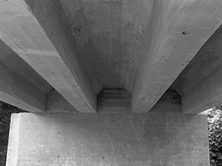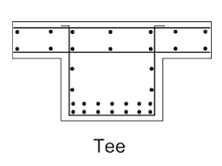 Buncombe County Bridge 240 over the Swannanoa River in Asheville, built by the county in 1920. Reinforced concrete tee beams retain marks of the wooden formwork from when they were cast in place (source: NCDOT bridge inspection files).
Buncombe County Bridge 240 over the Swannanoa River in Asheville, built by the county in 1920. Reinforced concrete tee beams retain marks of the wooden formwork from when they were cast in place (source: NCDOT bridge inspection files). Tee beam bridges have cast-in-place, reinforced concrete beams with integral deck sections to either side of the tops of the beams. In cross section the beams are deeper than their deck sections, which produces the T-shape that gives them their names.
The primary reinforcing steel is placed longitudinally in the bottom of the beam to resist the tension (the forces that would pull apart) on the beam. The deck that forms the top part of the T-shape is subject to compression (forces that squeeze or push it together). As concrete resists compression, it is concentrated in the deck along with less substantial reinforcing steel laid across the width of the bridge.
The development of the tee beam type in the early 20th century reflected a better understanding by engineers of the forces of compression and tension within reinforced concrete bridges. The bridges were strong because the reinforcing steel and concrete were placed where they were most needed, and economical because material was not wasted.
Tee beams were poured as a unit, regardless of how many parallel beams were required to form the bridge. They were generally used for spans 25- to 60-feet-long, but multiple spans allowed for the construction of long bridges. The no-longer-standing Tarboro Bridge (Edgecombe County Bridge 24), which was built to carry Tarrboro’s Main Street (N.C. 33) over the Tar River in 1931, had 10 equal-sized spans that extended a total of 490 feet.
 A section of reinforced concrete tee beam, with reinforcing steel shown as black circles (source: FHWA, Bridge Inspector's Reference Manual, 2012). Tee beams began appearing in the United States between 1905 and 1910 and spread rapidly in the 1910s. Tee beam bridges were first used in North Carolina about 1910 by counties, cities and railroads.
A section of reinforced concrete tee beam, with reinforcing steel shown as black circles (source: FHWA, Bridge Inspector's Reference Manual, 2012). Tee beams began appearing in the United States between 1905 and 1910 and spread rapidly in the 1910s. Tee beam bridges were first used in North Carolina about 1910 by counties, cities and railroads.
Among the oldest surviving examples are three overpasses built by the Southern Railway from 1917 to 1919 in Bessemer City (Gaston County Bridge 165), Concord (Cabarrus County Bridge 266), and Kings Mountain (Cleveland County Bridge 426). The bridges were part of a project important in the history of the Southern Railway — the realignment, regrading, double-tracking and grade-crossing improvement of the trunk line south from Washington to Atlanta.
The tee beam emerged as one of the most popular designs, with standard plans first prepared in late 1919. Early prototypical examples are scattered throughout the state, many located on pristine sections of bypassed old state routes.
The first standard designs consisted of three longitudinal beams. In the late 1920s the standards were updated for wider roadways, and later examples usually consisted of four or more beams.
Tee beams were used ubiquitously through the 1920s and 1930s. They continued to be popular through the 1950s, although they now faced competition from steel stringer technology in the same range of span lengths.
By the early 1960s the State Highway Department was phasing out the tee beam in favor of prestressed concrete beam bridges. The cast-in-place, tee beam bridges were labor intensive owing to the requisite formwork and they had increasingly high labor costs.
The state has 795 tee-beam highway bridges with dates of construction from 1916 to 1960.